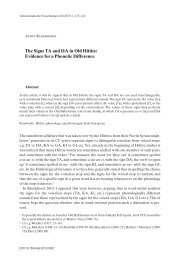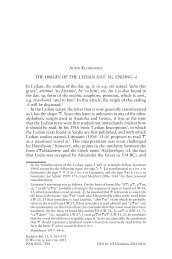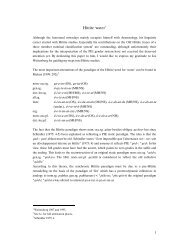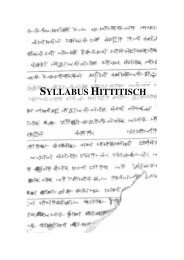Indo-European Nominal Ablaut Patterns - Alwin Kloekhorst ...
Indo-European Nominal Ablaut Patterns - Alwin Kloekhorst ...
Indo-European Nominal Ablaut Patterns - Alwin Kloekhorst ...
Create successful ePaper yourself
Turn your PDF publications into a flip-book with our unique Google optimized e-Paper software.
however, which clearly betray the amphikinetic origin of these nouns. I set up the following<br />
chronology of developments: 36<br />
hysterodyn. amphikinetic OH NH<br />
nom.sg. *h1lénǵ h -i = *h1lénǵ h -i >> *h1lénǵ h -ōi = *h1lénǵ h -ōi >> link-ai-š = linkaiš<br />
acc.sg. *h1lnǵ h -éi-m >> *h1lénǵ h -oi-m = *h1lénǵ h -oi-m = *h1lénǵ h -oi-m > link-ai-n = linkain<br />
gen.sg. *h1lnǵ h -i-és = *h1lnǵ h -i-és = *h1lnǵ h -i-és >> *h1lénǵ h -i-os > link-i-aš >> linkai̯ aš<br />
nom.sg. *h3ér-nu = *h3ér-nu >> *h3ér-nōu = *h3ér-nōu >> ḫar-nau-š = ḫarnauš<br />
acc.sg. *h3r-néu-m >> *h3ér-nou-m = *h3ér-nou-m = *h3ér-nou-m > ḫar-nau-n = ḫarnaun<br />
gen.sg. *h3r-nu-és = *h3r-nu-és = *h3r-nu-és >> *h3ér-nu-ós > ḫar-nu-aš >> ḫarnau̯ aš<br />
In the original hysterodynamic paradigm *CéC-C, *CC-éC-m, *CC-C-és, first the full grade of the<br />
root was generalized from the nominative to the accusative, yielding *CéC-C, *CéC-oC-m, *CC-C-és.<br />
Then the accusative stem was introduced into the nominative, yielding the paradigm that is called<br />
‘amphikinetic’, *CéC-ōC, *CéC-oC-m, *CC-C-és. Introduction of the full grade of the root from the<br />
nominative and accusative into the oblique cases yielded *CéC-ōC, *CéC-oC-m, *CéC-C-os. After<br />
addition of the nom.sg. ending *-s, this paradigm yielded OH *CéC-aC-š, *CéC-aC-n, *CéC-C-aš.<br />
The generalization of the full grade vowel of the suffix from the nominative and accusative into the<br />
oblique cases then yields the NH paradigm *CéC-aC-š, *CéC-aC-n, *CéC-aC-aš. This development<br />
can be regarded as the last step in a chain of developments that all took place in order to regularize the<br />
original paradigm.<br />
Other examples are e.g. Hitt. ḫāran- ‘eagle’ and šīu̯ att- ‘day’:<br />
hysterodyn. amphikinetic pre-Hitt. OH<br />
nom.sg. *h3ér-n = *h3ér-n >> *h3ér-ōn = *h3ér-ōn > *ḫār-an >> ḫāraš<br />
acc.sg. *h3r-én-m >> *h3ér-on-m = *h3ér-on-m = *h3ér-on-m > *ḫār-an-an = ḫāranan<br />
gen.sg. *h3r-n-és = *h3r-n-és = *h3r-n-és >> *h3ér-n-ós > *ḫār-n-aš >> ḫāranaš<br />
nom.sg. *diéu-t = *diéu-t >> *diéu-ot = *diéu-ot > *šīu-at >> šīu̯ az<br />
acc.sg. *diu-ét-m >> *diéu-ot-m = *diéu-ot-m = *diéu-ot-m > *šīu-att-an = *šīu̯ attan<br />
gen.sg. *diu-t-és = *diu-t-és = *diu-t-és >> *diéu-t-ós > *šīu-tt-aš >> šīu̯ attaš<br />
Interestingly, within the paradigm of šīu̯ att-, an archaic endingless locative is attested, namely šīu̯ at.<br />
This form reflects a virtual *diéu-ot, which in view of the developments described above probably<br />
goes back to an original form *diu-ét. This form is therewith the Anatolian pendant to forms like Skt.<br />
loc.sg. kṣám(i) ‘on the earth’ < *d h ǵ-ém(-i) or tmán ‘in the soul’ < *h1h1t-mén(-i), which prove the<br />
existence of hysterodynamic locatives of the shape *CC-éC(-i).<br />
(10) Conclusions<br />
We have seen that the Anatolian language branch provides evidence for nominal paradigms inflecting<br />
according to the following ablaut patterns:<br />
- the static one, as reconstructed in both the Erlangen and the Leiden model (albeit that I find evidence<br />
for the ablaut grade *e only, and not *o/e or *ē/e).<br />
- the proterodynamic one, as reconstructed in both the Erlangen and the Leiden model.<br />
- the hysterokinetic one, as reconstructed in the Erlangen model.<br />
- the amphikinetic one, as reconstructed in the Erlangen model.<br />
36 I now retract my treatment of the prehistory of the Hittite diphthong stems, ḫāran- and šīu̯ att- as given in<br />
<strong>Kloekhorst</strong> 2008: 106.<br />
10






